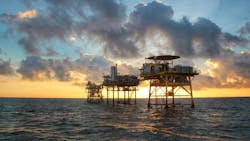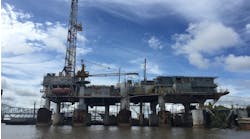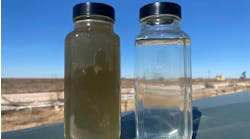New research illuminates P&A cost trends in the shallow-water GoM
Editor's note: This story first appeared in the November-December 2022 issue of Offshore magazine. Click here to view the full issue.
By Mark J. Kaiser, Center for Energy Studies, Louisiana State University
The BSEE has collected decommissioning expenditure data from operators in the Gulf of Mexico since 2016 to estimate the decommissioning liability of federal leases. BSEE uses this data to compute expected decommissioning cost for active wellbores, structures, and pipeline segments but does not otherwise disclose the statistical results of their data collection efforts or methods employed in cost estimation.
In Part 2 of this series, we summarize average well plug and abandonment cost in the shallow water (<122 m, <400 ft) Gulf of Mexico, and demonstrate how BSEE applies water depth and measured depth in its cost functions.GoM decom history
Throughout most of the history of the offshore oil and gas industry in the US Outer Continental Shelf, the federal government neither collected nor required operator’s report cost data at the completion of decommissioning activity. Reporting decommissioning cost data was optional, and although a few companies submitted data to the Minerals Management Service MMS (forerunner to the Bureau of Safety and Environmental Enforcement, BSEE), the vast majority did not. As a result, decommissioning cost data sets were sparse and generally insufficient/unreliable for cost estimation and decommissioning liability determination.
In the 1980s, when decommissioning activity in the Gulf of Mexico was in its infancy, neither operators nor the federal government paid much attention to the issue, and because of the regulatory provisions in place – where all previous owners of a property are jointly and severally responsible for decommissioning should current owners be unable to perform their requirements – the regulatory framework was considered adequate to protect taxpayers. As properties increasingly changed hands down the food chain, however, it began to be recognized that accurate decommissioning cost estimates were necessary to ensure that adequate financial resources were in place, regardless of the regulatory provisions.
Starting in April 2016, operators in the Gulf of Mexico were required to submit decommissioning expenditures after completion of permanent plugging of any well, removal of any platform or facility, and clearance of any site (NTL No. 2016-N03).
BSEE does not disclose their data collection efforts, not even in summary form, nor does it report on the methods or cost estimation procedures employed. This is unfortunate because cost data, even summary data, is useful to benchmark operations, track market conditions, and otherwise inform the industry on cost trends, as shallow-water production in the Gulf of Mexico declines (see Part 1, July-August 2022 Offshore). There are good practices that should be employed in cost estimation, and these often require experience and judgement, and so without disclosure on the data, methods, or evaluation techniques, questions naturally arise regarding the efficacy of BSEE analysis and results.
NTL No. 2016-N03
In NTL No. 2016-N03, BSEE required operators to submit decommissioning expenditures within 120 days after completion of permanent plugging of any well, removal of any platform or facility, and clearance of any site. In late 2016, BSEE amended the rule to include pipeline decommissioning; and in 2017, issued additional guidance to clarify standards regarding the submission of decommissioning cost data (NTL 2017-N02).
In reporting, lessees are expected to use methods, procedures, and expenditure classifications set out in model forms and accounting guidelines from the Council of Petroleum Accountants Societies. This kind of guidance can help ensure that consistent cost categories are utilized by operators.
BSEE requires separate summary submissions of decommissioning expenditures for each decommissioned asset (well, platform and facilities, pipeline segment, site cleared) performed in the Gulf of Mexico. The agency applies invoice-level allocations among decommissioned assets and cost categories according to (1) Transportation and Staging, (2) Location, (3) Contract Services, Lifting, Diving and Service Units, and (4) Other Decommissioning Related Costs.
Conductor severance and removal cost estimates for caissons and fixed platforms are allocated to well plugging and abandonment if the activity occurs during structure removal.
Operators are also required to provide a certification statement attesting to the “truth, accuracy and completeness” of the decommissioning expenditure report at the time of submission.
2016-2021 Decommissioning
From April 2016, when NTL No. 2016-N03 was released requiring operators to submit decommissioning cost data, through the end of 2021, 1,764 wells were permanently abandoned and 578 platforms were decommissioned in the shallow-water Gulf of Mexico. Of the 578 structures decommissioned, 190 were caissons and 388 were fixed platforms.
Operator data reported during the period 2016-2021 thus constitutes a reasonably large and diverse data set which should be adequate for BSEE to perform reliable decommissioning cost estimation. Using the operator-reported cost, BSEE computes cost statistics and applies other algorithms to establish expected decommissioning cost for the active inventory.
Active inventory c. 2022
The active inventory of shallow-water wells circa 2022 is approximately 6,456 wells. This includes 3,712 completed wells and 2,744 temporarily abandoned wells. Exploration and appraisal wells that have not been completed are not included in the tally.
The active inventory of shallow-water structures in 2022 totaled 1,424, including 397 caissons and 1,027 fixed platforms.
BSEE estimates the decommissioning cost for each of these assets, as well as the active pipeline inventory and site clearance cost, and reports this data on a leasehold basis.
TA vs. PA wells
Permanently sealing a well is a specialized scope of work, and the exact requirements depend upon the characteristics of each well and the number of zones it penetrates beneath the seabed. Generally, plugging and abandoning a well involves setting mechanical barriers at multiple locations down the wellbore, and filling certain sections of the well between these barriers with cement. Industry practice is for each producing formation zone to require its own cement section, but multiple zones may be grouped together if in close proximity. Ultimately, a permanent seal is put in place that will prevent hydrocarbons from being released in the environment in the future.
A well in which all the required plugs are in place but the casing is not cut is called a temporary abandoned (TA) well. All things being equal, the average cost to take a TA well into permanent abandonment (PA) status will be less expensive than taking a completed well into PA status, since in the former case the well has already been plugged and the time/cost associated with this activity no longer needs to be performed. TA operations essentially cover the cost to rig up, enter the wellbore, place the cement plugs, remove production tubing, and test the integrity of the plug.
After the well plugs are placed, the casing and conductor is cut and pulled, which may occur during P&A operations or before structure removal. If operators cut and pull conductor casing as part of structure removal activity, BSEE requires that the operator report these costs separately, along with the number of conductors removed, so that they can (re)allocate these costs to well abandonment expenditures and more accurately represent the cost of well abandonment. In other words, conductor cutting and removal cost are allocated to the PA cost category, even if the activity/cost was included as part of structure removal.
Cost statistics
In water depth less than 30 m, the average cost to take a completed well to PA status is estimated at about $500,000 per well, whereas to permanently abandon a TA well costs on average $142,000 (Table 1). The difference in cost between these two different well states represent the (average) cost to enter a well, pull tubing, and plug the producing formations with cement according to regulatory guidelines.
As water depth increases, the cost to PA wells from both starting points (completed well or TA well) also increases, since the remaining cost in both cases is to cut and pull conductor from the wellbore which depends on the length (i.e., water depth) of conductor.
Taking a TA well to PA status costs about $350,000 in water depths from 30-60 m, and about $500,000 in water depths from 61-122 m.
For completed wells, the average cost to reach PA status is about $700,000/well in water depths from 30-60 m, and $900,000/well in water depths from 61-122 m.
The difference in average cost between the two initial states does not vary much across water depth category, between $349,000 and $397,000, and essentially represents the plugging (cutting/pulling tubing, cement job and related) cost of the operation.
As a percentage of total PA cost, cutting and lifting conductor cost increase from 28% in <30 m, to 50% in 31-60 m, and 56% in 61-122 m water depth. Therefore, plugging cost as a percentage of total PA cost decreases with water depth on average from 72% (<30 m) to 44% (61-122 m).
Cost functions
There were 6,456 active wells in shallow water in 2022 and a plot of P50 PA cost by water depth shows the two main features used in BSEE cost modeling (Figure 1).
Two distinct mostly non-overlapping groupings of data are apparent, and both show an upward trend. Clearly, water depth is being used as a factor in the P50 PA cost estimates.
For the most part, the top cluster represent completed wells, while the bottom cluster only represent TA wells. However, some TA wells also fall within the top cluster and their presence amongst completed wells suggests that some TA wells are either misclassified or their cost miscalculated.
A vertical spread of cost is apparent in both clusters, more so in the top cluster (completed wells), which indicates that BSEE is using a secondary attribute to distinguish between individual wellbores. We will see shortly that the secondary attribute is measured depth. For completed wells, PA costs range from about $200,000 to $800,000 in water depth <20 m, and from $800,000 to $1,400,000 in 100 m water depths. For TA wells, PA costs top out at about $400,000 in water depths less than 100 m.
It is easy to approximate the average trendline in Figure 1 for the two well classes (ignoring for the moment TA wells that occur amongst the top cluster) using a ruler, whereby we obtain:
P50 PA Well Cost (TA) = αTA ‧ WD
P50 PA Well Cost (COM) = $450,000 + αCOM ‧ WD
where P50 PA describes the median permanent abandonment well cost in dollars for TA and COM wells, and WD denotes water depth in meters. The αTA and αCOM coefficients for TA and COM wells are approximately αTA = $4,000/m and αCOM = $5,000/m.
The trendlines for COM and TA wells are not parallel, but they are quite close, and for the COM well cluster we used the median line between the upper and lower boundary lines. The average COM well cost relation is essentially the TA cost curve shifted upward by about $450,000, which represents the average COM well plugging cost across all water depths. The variation in the COM well cost data is explained using measured depth as illustrated next.
In Figure 2, seven lease blocks in the West Delta area are depicted showing P50 PA well cost for completed wells. The blocks WD30 and WD31 are adjacent and have maximum water depths of 16 m and 19 m, respectively. WD68 (38 m) and WD70 (45 m) are separated by one block. WD104 (77 m) and WD105 (79 m) are adjacent and WD133 has maximum water depth of 94 m.
Note that all cost curves are approximately parallel (have similar slopes), adjacent blocks have close (overlapping) cost curves; and as water depth increases, the cost curves shift upward. The y-intercepts of these trendlines are used (see Figure 3) to extract the P50 PA cost curve dependence on measured depth.
Using all the active leases in West Delta (seven of which are shown in Figure 2), the y-intercepts of individual curves were computed and regressed as a function of water depth as shown in Figure 3. The slope of the resulting line is $6,930/m.
For an individual completed well, we can therefore apply the general cost function:
P50 PA Well Cost (COM) = αCOM ‧ WD + βCOM ‧ MD
Using αCOM = $6,930/m for the West Delta region, P50 PA cost for any well can be computed using its water depth in meters and measured depth (MD) in feet.
For a given area block, the coefficient β generally ranges between $30/ft to $35/ft, while α varies from $6,000/m to $8,000/m.
The aforementioned classification problems with TA wells preclude a similar evaluation for TA wells.
Measured depth has been suggested as a PA cost factor onshore with limited (and rather unconvincing) empirical support, but no evidence offshore is available in the literature, so widespread application of measured depth is troubling without supporting documentation and statistical evidence. In theory, there is nothing wrong to posit and apply a measured depth relation in cost functions, but it needs to be demonstrated as valid.




